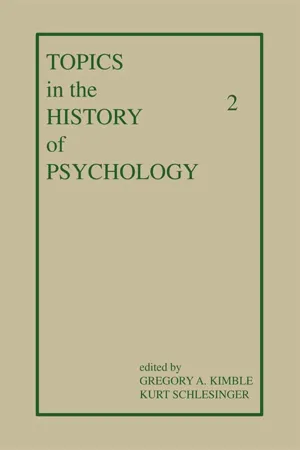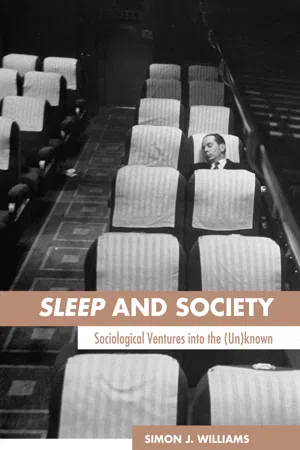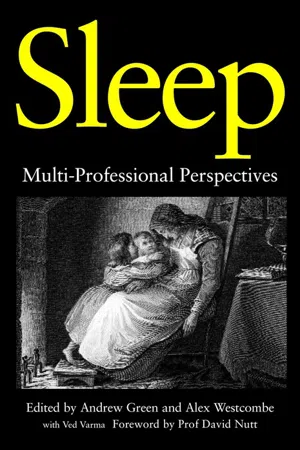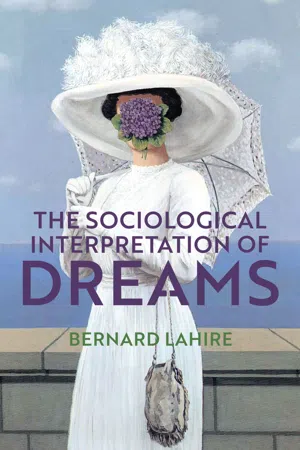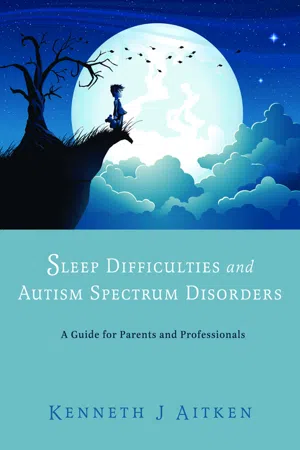Psychology
Theories of Sleep
Theories of sleep in psychology encompass various perspectives on the functions and mechanisms of sleep. These theories include the evolutionary, restorative, and cognitive theories, each offering different explanations for why we sleep and the processes involved. Evolutionary theories suggest that sleep evolved as a protective mechanism, while restorative theories propose that sleep is necessary for physical and mental rejuvenation. Cognitive theories focus on the role of sleep in memory consolidation and learning.
Written by Perlego with AI-assistance
Related key terms
7 Key excerpts on "Theories of Sleep"
- eBook - ePub
Topics in the History of Psychology
Volume II
- G. A. Kimble, K. Schlesinger(Authors)
- 2014(Publication Date)
- Psychology Press(Publisher)
The interdisciplinary nature of this effort is apparent. It moves across the biochemical substrata, the action of single nerve cells, the neurophysiological network, the interactions of sleep with endocrine systems and physiology, the ontogeny of sleep, the phylogeny of sleep, pathological conditions and psycho-pathology relations, the interactions with performance and learning, the effects of external stimuli and schedules, the relations to drugs, and the entire panorama of these variables in relation to dreams. Scientists from many disciplines are involved in sleep research. We find biochemists, neurologists, physiologists, pediatricians, pharmacologists, psychiatrists, psychoanalysts, and zoologists—and, of course, psychologists. The latter group has tended to focus on the interrelations between sleep and behavioral manifestations and on the cognitive aspects of dreams.Within the disciplines involved, sleep, as an area, remains of marginal interest; it is a peripheral concern of many, but central to none. This is typified by the relationship to psychology. A survey of the major introductory textbooks of 1960 (Webb, 1961) revealed that four made no reference to sleep, one had two paragraphs, and the most extensive treatment was two pages. A survey of 10 recent introductory tests (Webb, 1981) found that all include sleep and the number of pages ranges from 3 to 17. In most cases sleep is treated as an “altered state of consciousness,” along with hypnosis and drug-induced states.Clearly, as seen in the bottom row of Table 6.3 , the field has grown rapidly since the 1950s. That this essentially exponential increase in publications exceeds the general explosion of research publications can be judged by comparison with research publications in psychology. The numbers of Psychological Abstracts for the years 1950, 1967, 1972, 1977, and 1980 were 6563, 17202, 24326, 27009, 26831, respectively. Thus, the increase in papers was 4-fold, while sleep research papers increased 20-fold.CURRENT PERSPECTIVESDifficulties of achieving “current perspective” are pointed to by the two nuances of the word “perspective”: “capacity to view things in their true relations or relative importance,” and “a visible scene, especially one giving a distinctive impression of distance” (Webster’s Collegiate Dictionary). Sleep research sprawls across a wide range of particularized concerns, and each plunges into complexities of techniques. Each effort holds an importance, and its complete comprehension demands particular expertise. Understanding of its “true relations” may lie in the future. The problem that an active participant in a field faces in achieving Olympian “distance” is as great as that of a foot soldier midst a battle in a great war. This final section is written within these limits of “perspective.” - eBook - ePub
Sleep and Society
Sociological Ventures into the Un(known)
- Simon J. Williams(Author)
- 2013(Publication Date)
- Routledge(Publisher)
1 Changing theories and explanations of sleep From ancient to modern times DOI: 10.4324/9780203000885-1Introduction
Sleep has always been one of those great mysteries of life, something we all do but no less mysterious for that. In this chapter I take a preliminary look at the nature and status of sleep, and at attempts to unravel its causes, complexities and mysteries, with particular reference to some of the main philosophical, scientific and literary sources and contributions to this debate through the ages, from ancient to modern times: a history of changing ideas, theories and explanations of sleep, or the social construction of sleep if you like, including past and present discourses and debates on the pains if not the pathologies of sleep and the weird and wonderful world of dreams and dreaming, albeit as subsidiary themes. The chapter, in this respect, provides a first stab at the nature and status of the phenomenon under investigation and a backdrop to some of the other more sociological themes and issues that follow.What then do we ‘know’ about the nature and status of sleep, and how have these ideas, theories and explanations changed or evolved over time?Past theories and evolving ideas: from ‘passive’ to ‘active’ sleep?
Sleep has fascinated (and frustrated) people since time immemorial, with many different ideas and explanations put forward as to its nature and its causes through the ages, both Eastern and Western, ‘passive’ and ‘active’ in kind, including ancient Mesopotamian, Egyptian and Chinese beliefs and practices dating way back to 3000bc .For our purposes, however, somewhat arbitrarily perhaps, it is to Ancient Greek thought that we first turn in search of answers to these questions. Theories and explanations of sleep were clearly and systematically articulated at this time by many great writers in the history of Western thought. Alcmaeon, for example, in the fifth century BC, has been credited with what is possibly the ‘first theory of the cause of sleep’, postulating that sleep occurred when the blood vessels of the brain filled with blood, with wakefulness restored through withdrawal of blood from the brain: an early vascular ‘congestion’ theory, that is to say (Thorpy 1991 : xvi). Hippocrates (460–370bc ), the father of Western medicine, also speculated on the cause of sleep, believing, contra Alcmaeon, that it was due to blood going in the opposite direction, from the limbs to the inner regions or central parts of the body, where it was warmed, thereby resulting in sleep (Dannenfeldt 1986 ; Thorpy 1991 - eBook - ePub
Sleep
Multi-Professional Perspectives
- Alex Westcombe, Andrew Green(Authors)
- 2012(Publication Date)
- Jessica Kingsley Publishers(Publisher)
2
The Science of Sleep
WHAT IS IT, WHAT MAKES IT HAPPEN AND WHY DO WE DO IT?
Louise M. Paterson2.1. What is sleep?
Sleep occupies approximately a third of our lives and despite decades of study, we are only just beginning to understand its function. We now know that sleep is an active physiological process within the brain rather than a passive experience, and that it is highly regulated and controlled. It is also becoming apparent that good sleep is essential for normal brain function and for our overall health and well-being.Sleep can be defined as a natural, periodic state of immobility where the individual is relatively unaware of the environment and unresponsive to external sensory stimuli. Nearly all voluntary muscles become inactive and metabolic rate is reduced. The brain, however, is far from inactive; brain waves display characteristic patterns that differ from those displayed during wakefulness or coma. It is important to make a clear distinction between sleep and other states of consciousness. For centuries it was wrongly assumed that consciousness ceased at sleep onset and resumed with waking. Sleep is better represented as a reorganization of brain activity where consciousness could be considered to be ‘dulled’. Importantly, one is easily awoken from sleep, which also distinguishes it from coma, anaesthesia or from hibernation.1 A particular sleeping position and sheltered site is usually adopted. Another important feature is that if sleep is lost or prevented, recovery sleep usually occurs in order to compensate for the loss.The definition of sleep can be applied to humans as well as to most terrestrial mammals and birds, with only a few exceptions. There are notable differences for aquatic mammals, many of which can maintain mobility whilst asleep. A form of sleep that occurs in more primitive creatures requires more simplistic definitions. - eBook - ePub
- Jim Barnes(Author)
- 2013(Publication Date)
- SAGE Publications Ltd(Publisher)
SLEEP AND BIOLOGICAL RHYTHMSCHAPTER OUTLINE Biological rhythms The suprachiasmatic nucleus (SCN) Influence of light–dark cycle How much sleep do people require? Measuring sleep Sleep stages REM sleep Ponto-geniculo-occipital (PGO) waves Sequences of NREM and REM sleep Neural mechanisms of sleep Passive sleep theory Active reticular activation system theory Hypothalamus Basal forebrain Raphe nucleus Theories regarding reasons for sleep Evolutionary theory of sleep Repair and restoration theory of sleep Information consolidation theory of sleep Sleep disorders Insomnia Sleep-related breathing disorders: sleep apnoea Hypersomnia: narcolepsy Circadian rhythm sleep disorders Parasomnias Summary Further reading Key questionsSleep is a natural restful state that occurs in humans and other animals. During sleep, the person or animal is less able to react to external stimuli in the environment. While it seems that regular sleep is necessary for many animals to survive, a great deal of research is being done to determine why we spend so many hours of our lives sleeping. In this chapter, we will review the key theories attempting to explain the need for sleep and an overview of the biological mechanisms of sleep.BIOLOGICAL RHYTHMSThese periodic biological fluctuations in an animal correspond to, and are in response to, environmental changes that occur. The cyclic environmental variations include changes in the relative position of the earth to the sun and to the moon, as well as the effect of these variations, such as the day following night and the position of tidal heights. ‘Biological clock’ refers to the internal bodily mechanism that maintains these fluctuations even when environmental cues are not present. When one travels across time zones, the environmental cycle moves out of alignment with the body’s internal cycle, and the body’s internal clock continues to function for a while in concert with the original environmental cycle. When this happens, a person may feel fatigued and tired for a few days following the trip, during which time the person is said to be suffering from a condition called jet lag. - eBook - ePub
- Bernard Lahire, Helen Morrison(Authors)
- 2020(Publication Date)
- Polity(Publisher)
9The Context of SleepDefining dreams through sleep(Gabriel Tarde, Sur le sommeil, p. 50)In the course of the preceding chapters, we have seen how the incorporated past, the existential situation and triggering elements interlink in the process of oneiric production. The final key element of the general formula for the interpretation of dreams1 is the context of sleep – that is to say, the context within which the dream images unfold.The dream is a form of expression with structural properties that are linked to the particular conditions of its enunciation. In spite of his hesitations about turning it into an object of sociological study, Maurice Halbwachs correctly identified the problem of the dream by observing that the difference ‘between dream thoughts and waking thoughts’ lies in the fact that ‘they do not both develop in the same context.’ In spite of their differences in approach, Maury and Freud nevertheless were in agreement on this question:When Maury compares dreams to certain forms of insanity, he senses that, in both cases, the subject is living in his own world, where relationships are established between people, objects, words, which make sense only to him. Outside the real world, forgetting both the physical laws and the social conventions, the dreamer, like the lunatic, undoubtedly engages in an internal monologue.… But when Freud attaches to the dream visions the value of signs whose meaning he looks for in the hidden preoccupations of his subject, he is essentially saying the same thing.2 - eBook - ePub
Sleep Difficulties and Autism Spectrum Disorders
A Guide for Parents and Professionals
- Kenneth Aitken(Author)
- 2012(Publication Date)
- Jessica Kingsley Publishers(Publisher)
The similarities in the underpinning biological processes, across the animal kingdom, are allowing significant developments in our understanding of human sleep to be made through the study of its development in other ‘model organisms’ such as Drosophila melanogaster (the fruit fly) and Danio rerio (the zebrafish) (Hendricks, Sehgal and Pack 2000). In addition to sleep–wake cycle issues, mood disorders including unipolar depression and seasonal affective disorder are typically due to abnormalities of the circadian system (McClung 2007; Monteleone and Maj 2008). There is a growing body of evidence that circadian abnormalities are seen in a large proportion of individuals with ASDs (Glickman 2010). Methods for the reliable assessment of human circadian rhythms are now available and in use (see Hofstra and de Weerd 2008). Variations in cognitive ability follow a circadian pattern and are affected both by endogenous circadian clocks and external factors that vary the amount and timing of actual sleep (Kyriacou and Hastings 2010). W HAT IS SLEEP? A useful starting point in understanding and unravelling sleep problems is trying to get a basic idea of what sleep is, why we might do it and what it might be for. We should start by defining what we mean by sleep. There are many definitions to choose from. Here is a selection: Sleep is a reversible condition of reduced responsiveness usually associated with immobility. (Cirelli and Tononi 2008, p.1605) …sleep is that golden chain that ties health and our bodies together. (Thomas Dekker, The Gull’s Hornbook 1609) Sleep is the interest we have to pay on the capital which is called in at death; and the higher the rate of interest and the more regularly it is paid, the further the date of redemption is postponed. (Arthur Schopenhauer) Sleep that knits up the ravelled sleave of care, the death of each day’s life, sore labour’s bath, balm of hurt minds, great nature’s second course, chief nourisher in life’s feast - eBook - ePub
- William C. Kohler, Peter J. Kurz(Authors)
- 2017(Publication Date)
- Routledge(Publisher)
There are many extraordinary works readily available (some listed in our references) which can provide the interested reader with a thorough understanding of our current state of knowledge. The purpose of this chapter and the next is to show how until now the flow of our understanding of the state of sleep has been based primarily on myths, legends, and descriptions or personal recollections through art, literature, and the words of philosophers; and that this started to change in a very significant and rapid way very recently – only a few decades ago. To a lesser extent, the same may be the case with hypnosis but, we believe, in a different manner, which will also be summarized in later chapters.Everywhere, from the earliest days, our ancestors and those around them were curious and perplexed about the nature and meaning of sleep. They couldn’t quite understand how or why it happened and, in many cultures, associated sleep with death. We have seen how the Greeks related the two through the myth of the brothers Sleep and Death (Hypnos and Thanatos) and their sisters, the three Keres. Another way was to believe that sleep was merely “a short death” in contrast with death, “a long sleep.” Through a great variety of myths and fables our ancestors tried to understand and to explain the meaning of sleep. Many of these early attempts survived time and traveled from one region to another. For almost 18 centuries, the early Greek myths were replaced by the more “scientific” reasoning of Plato, Aristotle, and others who believed that the gases rising from our stomachs as food decomposed somehow affected the brain and caused periodic sleep. Other versions claimed that blood had a way of flooding the head and that such cyclical incoming and outgoing tides caused sleep.Within the past century our understanding changed radically as new tools were developed and helped us see better, to analyze, study, and understand in a very different way. These tools give us our new ability to look inside the sleeping brain. Through the actual recording of electrical activity in the brain, scientists are now engaged in the emerging new science of sleep. We will show that many of the interpretations, depictions, and suppositions related to sleep that have been offered during the past millennia are not valid – that most were inaccurate. At the same time we will also try to show that in light of recent scientific findings we must marvel at the remarkable insights reflected in the works of many of these authors and artists.
Learn about this page
Index pages curate the most relevant extracts from our library of academic textbooks. They’ve been created using an in-house natural language model (NLM), each adding context and meaning to key research topics.
